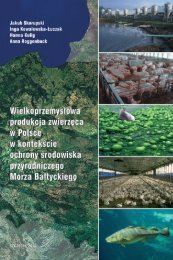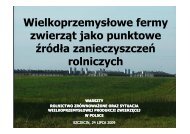best available technologies for manure treatment - Baltic Green Belt
best available technologies for manure treatment - Baltic Green Belt
best available technologies for manure treatment - Baltic Green Belt
Create successful ePaper yourself
Turn your PDF publications into a flip-book with our unique Google optimized e-Paper software.
Best Available Technologies <strong>for</strong> <strong>manure</strong> <strong>treatment</strong> baltic sea 2020<br />
Best Available Technologies <strong>for</strong> <strong>manure</strong> <strong>treatment</strong> baltic sea 2020<br />
ANNEX E: TABLES WITH SHORT DESPRIPTION OF LIVESTOCK MANURE TREATMENT TECHNOLOGIES<br />
Best Available Techniques <strong>for</strong> <strong>manure</strong> <strong>treatment</strong> - <strong>for</strong> intensive rearing of pigs in <strong>Baltic</strong> Sea Region EU Member States Technical Report "Best Practice Manure Handling, Phase 2"<br />
Ref No. 44 Pyrolysis / Thermal gasification<br />
Brief description Description of the effect on leaching (positive or negative) of N and P<br />
Thermal gasification can give higher efficiency as compared to combustion and fewer problems<br />
with corrosion.<br />
Thermal gasification adds heat (with or without oxygen, depending on the technology) to the<br />
incoming biomass and consists of two processes: Pyrolysis converting most organic substances<br />
into gasses at some 400-700 o Celsius in a Circulating Fluid Bed reactor giving rise to a charcoal,<br />
which in the following gasification in a second reactor also will be turned into gas.<br />
The resulting gas is not at present useful <strong>for</strong> all engine types.<br />
Thermal gasification of the solid separation fraction has been implemented on pilot basis in<br />
combination with other <strong>technologies</strong>.<br />
At present the process has faced the same challenges as the combustion technology by the EU<br />
Waste Incineration Directive (2000/76/EEC) and there<strong>for</strong>e it is not <strong>available</strong> on the market.<br />
Thermal gasification has some advantages as compared to<br />
combustion due to lower temperatures in the process:<br />
Less NOx emission<br />
Less dioxin emission<br />
More readily reuse of ash-P<br />
Generally, the P is not lost in this technology and can apparently be<br />
used directly into fertiliser production.<br />
Most of the N will be converted to N<br />
2<br />
, and there<strong>for</strong>e not leach.<br />
Innovation stage<br />
Investment price, <br />
Basic Variable<br />
Operational<br />
costs,<br />
per tonnes<br />
per kg saved N or P leaching Complexity of implementation<br />
Research <br />
Pilot <br />
Practice<br />
Major references<br />
Not presently <strong>available</strong><br />
as standalone<br />
technology at farm<br />
scale<br />
Condition <strong>for</strong> leaching<br />
reduction effect<br />
Jørgensen et al.,<br />
2008 Scenarios II to V.<br />
-<br />
Cannot be<br />
calculated at<br />
present<br />
Certainty of in<strong>for</strong>mation<br />
Prices ?<br />
Effect on<br />
leaching<br />
High<br />
Cannot be calculated at present. Economic<br />
feasibility studies should be made in all<br />
target countries. Potentially a rather<br />
expensive technology.<br />
Difficult to implement technically, with<br />
legislative challenges in relation to the<br />
interpretation of the EU Waste Incineration<br />
Directive<br />
68<br />
Side 70<br />
68








